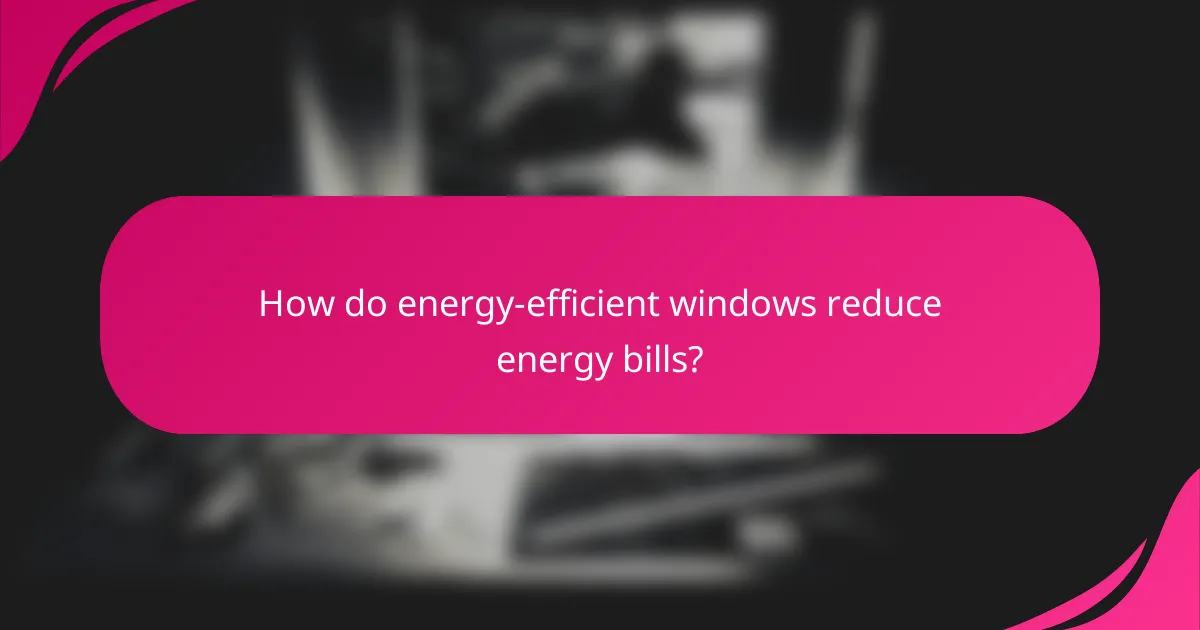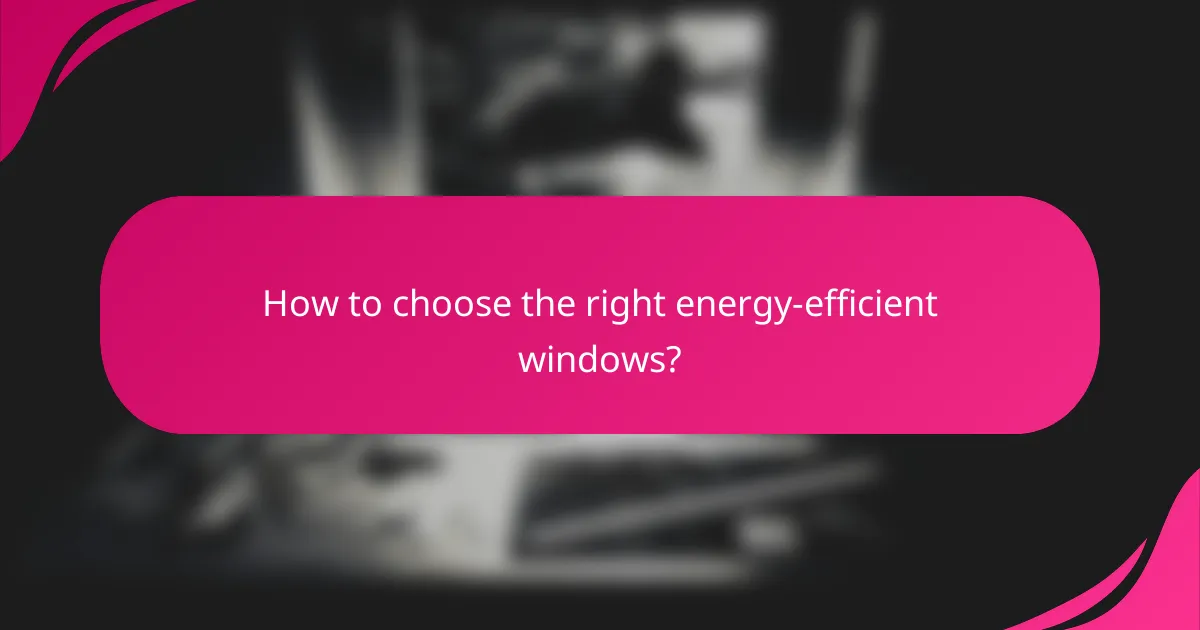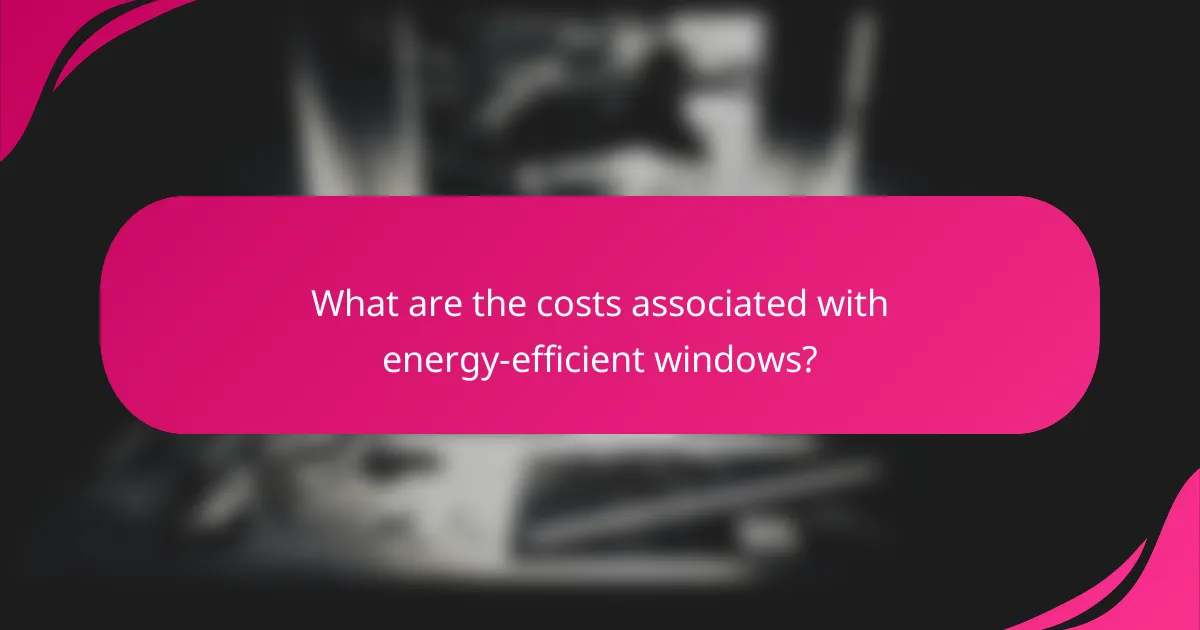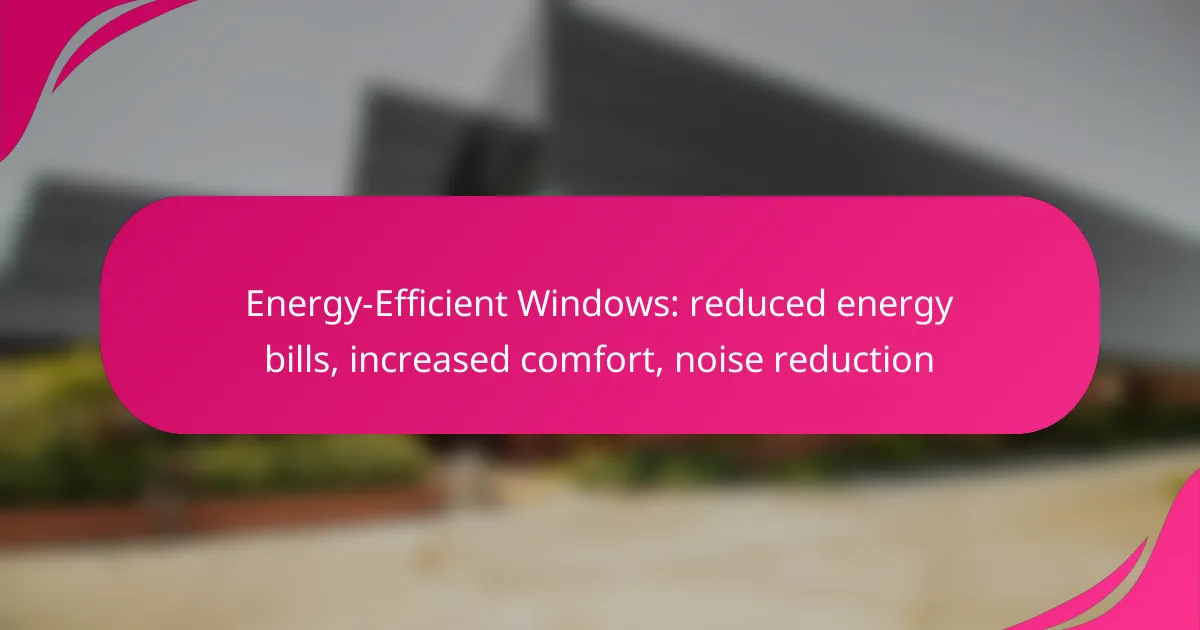Energy-efficient windows are a smart investment for homeowners, as they significantly reduce energy bills by minimizing heat loss in winter and heat gain in summer. These windows enhance indoor comfort by improving insulation and reducing air leakage, while also providing the added benefit of noise reduction, creating a more peaceful living environment.

How do energy-efficient windows reduce energy bills?
Energy-efficient windows lower energy bills by minimizing heat loss in winter and heat gain in summer, leading to reduced reliance on heating and cooling systems. By improving insulation and reducing air leakage, these windows help maintain a comfortable indoor temperature year-round.
Low U-factor windows
Low U-factor windows are designed to have a lower rate of heat transfer, which means they are better at keeping indoor temperatures stable. A U-factor of 0.30 or lower is generally considered energy-efficient. Choosing windows with a low U-factor can significantly decrease heating and cooling costs over time.
Double or triple glazing
Double or triple glazing refers to windows that have two or three layers of glass, respectively, separated by air or gas-filled spaces. This design enhances insulation by creating barriers that slow down heat transfer. Homes with double or triple-glazed windows often see a noticeable reduction in energy bills, particularly in extreme climates.
Low-E coatings
Low-E (low emissivity) coatings are thin, transparent layers applied to window glass that reflect heat while allowing light to pass through. These coatings help keep homes warmer in winter and cooler in summer, further reducing energy consumption. When selecting windows, look for those with a low-E rating for optimal performance.
Insulated frames
Insulated frames are constructed with materials that provide better thermal resistance than traditional frames. Common materials include vinyl, fiberglass, or wood with insulation. Investing in windows with insulated frames can enhance overall energy efficiency and comfort by minimizing heat transfer through the frame itself.
Air leakage reduction
Air leakage occurs when outside air enters or conditioned air escapes through gaps and cracks around windows. Energy-efficient windows are designed to minimize this leakage, often featuring weather stripping and tight seals. Proper installation and regular maintenance can further reduce air leakage, leading to lower energy bills and improved indoor comfort.

What are the benefits of energy-efficient windows in Los Angeles?
Energy-efficient windows in Los Angeles offer significant advantages, including lower energy bills, enhanced comfort, and reduced noise levels. These windows are designed to minimize heat transfer, making homes more comfortable and energy-efficient throughout the year.
Increased indoor comfort
Energy-efficient windows help maintain a consistent indoor temperature, reducing the need for heating and cooling systems. This is particularly beneficial in Los Angeles, where temperatures can vary widely between seasons. By minimizing drafts and heat loss, these windows create a more pleasant living environment.
Consider windows with double or triple glazing, which provide better insulation compared to single-pane options. This added insulation can lead to a noticeable difference in comfort levels, especially during extreme weather conditions.
Noise reduction
One of the key benefits of energy-efficient windows is their ability to reduce outside noise. In a bustling city like Los Angeles, sound insulation is crucial for maintaining a peaceful home environment. These windows often feature thicker glass and improved seals that help block unwanted sounds.
When selecting windows, look for models with a higher Sound Transmission Class (STC) rating, which indicates better noise reduction capabilities. This can significantly enhance your living experience, especially if you live near busy streets or entertainment districts.
UV protection
Energy-efficient windows also provide protection against harmful ultraviolet (UV) rays. These rays can cause fading of furniture, carpets, and artwork over time. Many energy-efficient window options come with special coatings that block a significant percentage of UV radiation.
By investing in these windows, you can help preserve the integrity and appearance of your interior spaces, ultimately saving money on replacements and repairs.
Enhanced property value
Installing energy-efficient windows can increase your property’s value, making it more attractive to potential buyers. In Los Angeles, where energy efficiency is a growing concern, homes with these upgrades often sell faster and at higher prices.
Consider this investment not just for immediate savings on energy bills, but also as a long-term enhancement to your home’s marketability. Energy-efficient features are increasingly sought after, making your property stand out in a competitive market.

How to choose the right energy-efficient windows?
Choosing the right energy-efficient windows involves understanding their performance ratings, materials, climate suitability, and available financial incentives. This ensures you select windows that effectively reduce energy bills, enhance comfort, and minimize noise.
Consider window ratings
Window ratings provide essential information about energy efficiency, typically indicated by the National Fenestration Rating Council (NFRC). Look for ratings such as U-factor, Solar Heat Gain Coefficient (SHGC), and Visible Transmittance (VT) to evaluate how well a window insulates, blocks heat, and allows light in.
For optimal performance, aim for windows with a low U-factor (below 0.30) and a moderate SHGC based on your climate. These ratings help ensure that your windows contribute to lower energy costs and increased comfort.
Evaluate frame materials
The frame material of energy-efficient windows significantly impacts their insulation properties and durability. Common materials include vinyl, wood, fiberglass, and aluminum, each with distinct advantages and disadvantages.
Vinyl frames are generally low-maintenance and provide good insulation, while wood frames offer excellent thermal performance but require more upkeep. Fiberglass frames are strong and energy-efficient, making them a solid choice, though often at a higher price point.
Assess local climate impact
Your local climate plays a crucial role in determining the best type of energy-efficient windows for your home. In warmer climates, windows with a low SHGC are preferable to reduce heat gain, while in colder areas, windows with a low U-factor are essential for retaining heat.
Consider local weather patterns and seasonal temperature variations when selecting windows. For instance, homes in regions with significant temperature fluctuations may benefit from triple-glazed windows for enhanced insulation.
Check for rebates and incentives
Many governments and utility companies offer rebates and incentives for installing energy-efficient windows, which can significantly offset initial costs. Research local programs that may provide financial assistance or tax credits for energy-efficient home improvements.
Check with your local energy provider or government website to find available incentives. This can help you make a more informed decision and maximize your investment in energy-efficient windows.

What are the costs associated with energy-efficient windows?
The costs associated with energy-efficient windows include both initial installation expenses and long-term savings potential. While the upfront investment can be significant, the benefits often outweigh these costs through reduced energy bills and increased comfort over time.
Average installation costs
The average installation costs for energy-efficient windows typically range from several hundred to over a thousand USD per window, depending on the type, size, and brand. Factors such as labor, removal of old windows, and additional features like low-emissivity coatings can influence the final price.
Homeowners should consider getting multiple quotes from contractors to ensure competitive pricing. It’s also wise to check for any local rebates or incentives that may help offset these costs.
Long-term savings analysis
Investing in energy-efficient windows can lead to substantial long-term savings on energy bills, often reducing heating and cooling costs by 10-25%. The exact savings depend on factors like local climate, energy rates, and the efficiency of the existing windows.
Over time, these savings can help recoup the initial investment, with many homeowners seeing a return on investment within 5-10 years. Additionally, energy-efficient windows can enhance property value, making them a worthwhile consideration for long-term homeowners.
Financing options available
Several financing options are available for homeowners looking to install energy-efficient windows. Many contractors offer payment plans or financing through third-party lenders, allowing homeowners to spread the cost over time.
Additionally, government programs and local utility companies may provide low-interest loans or rebates specifically for energy-efficient home improvements. Researching these options can help make the investment more manageable and financially viable.

What are the top brands for energy-efficient windows?
The leading brands for energy-efficient windows include Andersen, Pella, and Marvin. These manufacturers are recognized for their innovative technologies that enhance insulation, reduce energy bills, and improve overall comfort in homes.
Andersen Windows
Andersen Windows is known for its high-quality, energy-efficient window options that feature advanced glazing technologies. Their products often meet or exceed ENERGY STAR standards, ensuring significant reductions in heating and cooling costs.
When considering Andersen, look for their Fibrex material, which combines the strength of wood with the low-maintenance features of vinyl. This material helps in achieving better insulation and durability over time.
Pella Windows
Pella Windows offers a variety of energy-efficient windows that are designed to enhance comfort and reduce noise. Their windows are available with triple-pane glass options, which provide superior insulation compared to standard double-pane models.
It’s beneficial to explore Pella’s range of window styles and finishes, as they allow for customization while maintaining energy efficiency. Their products often come with a warranty, providing peace of mind regarding performance and durability.
Marvin Windows
Marvin Windows is recognized for its commitment to sustainability and energy efficiency. Their Infinity line features fiberglass windows that are highly energy-efficient and resistant to warping and fading.
When selecting Marvin windows, consider their Low-E glass coatings, which help reflect heat while allowing natural light to enter. This feature can significantly contribute to lower energy bills and a more comfortable indoor environment.
